|
g
 Religion - The aesir and the vanir by
Marcus, Gabriel, Simon, David
Religion - The aesir and the vanir by
Marcus, Gabriel, Simon, David
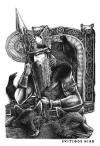
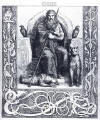

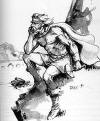
The ancient Nordic gods world consist of two gods relations, the aesir and
the vanir. The aesir lived in Asagård and formed the greater and
dominating group. Their leader was Odin and some other gods were Thor,
Balder, Heimdal and Tyr. There were also some goddesses: Frigge, Siv,
Nanna och Idun. The three most holy were Odin, Thor and Frej. Frej had a
twin sister, Freja, and their father was Njord. In the Viking Age, the
aesir were worshipped in the whole Scandinavia, but the cult was
especially strong in Sweden, because a powerful family in Sweden
“ynglingätten” counted Frej as their progenitor. Thor and Odin were war
gods. Frej and the other vanir had most connection to the animals and the
humans. According to the myths, it was from the beginning hostile
relations between the aesir and the vanir. Their hatred disappeared and
later on they lived in peace together. It shows how two different opinions
can adjust together.
Odin  was
the greatest god of all the aesir. Therefore he was called the king of
gods or the spear god. Odin was also the wisest god. Once Odin sacrificed
one of his eyes to drink from the Well of Wisdom. He was also the god of
war and death. His spear was called Gungner and it always hit its target.
Odin lived in the big castle called Valhall, which was the place where all
people that had died in a battle came to. Everyday they ate from the pig,
Särimner, and every morning Särimner became alive again. They drank loads
of mjöd, which is a type of beer that is brewed with honey and flavoured
with hops. Odin had two ravens, Hugin and Munin, and they stood for
thought and memory. Every morning they flew around the world, and in the
evening they returned to Odin and whispered in his ear what they had seen
and heard. Sometimes Odin left Valhall and rode on his eight-footed horse,
Sleipner. Sleipner ran fast on both water and land. Odin had two brothers,
Vile and Ve. The day Wednesday (onsdag in Swedish) got its name from Odin.
The son of Odin was Thor. was
the greatest god of all the aesir. Therefore he was called the king of
gods or the spear god. Odin was also the wisest god. Once Odin sacrificed
one of his eyes to drink from the Well of Wisdom. He was also the god of
war and death. His spear was called Gungner and it always hit its target.
Odin lived in the big castle called Valhall, which was the place where all
people that had died in a battle came to. Everyday they ate from the pig,
Särimner, and every morning Särimner became alive again. They drank loads
of mjöd, which is a type of beer that is brewed with honey and flavoured
with hops. Odin had two ravens, Hugin and Munin, and they stood for
thought and memory. Every morning they flew around the world, and in the
evening they returned to Odin and whispered in his ear what they had seen
and heard. Sometimes Odin left Valhall and rode on his eight-footed horse,
Sleipner. Sleipner ran fast on both water and land. Odin had two brothers,
Vile and Ve. The day Wednesday (onsdag in Swedish) got its name from Odin.
The son of Odin was Thor.
Thor  is
the son of Odin. Thor had red hair and a red beard and he is big, strong
and noisy. He was the most popular god of them all and he was often
fighting with the giants. The giants were the enemies of the people and
the aesirs. Thor was that kind of guy who did what he wanted to do, and
after that he thought over what he had done. He was the strongest of them
all and the aesir had him as a defence against the giants. Thor had a
hammer called Mjölner. Mjölner always hit its victims and returned to the
person that threw it. Thor had a pair of iron gloves to catch Mjölner
with, without getting hurt. One of many treasures was his belt of strength
that doubled his strength. His castle had 540 rooms and one of the rooms
was called Bilskirner. In that room he lived with his wife Sif. Thor was
the god of thunder. When it was thunderstorm outside, people thought that
it was Thor riding his wagon dragged by his goats hitting the iron wheel
so it became lightning. Many people wore Thor’s hammer as jewellery. The
day Thursday (torsdag in Swedish) came from Thor’s name, and also names
for boys like Thorbjörn, Torulf, Tore and Torkel. And not just that, even
many names of small towns like Torås, Torshälla and Torsby.
is
the son of Odin. Thor had red hair and a red beard and he is big, strong
and noisy. He was the most popular god of them all and he was often
fighting with the giants. The giants were the enemies of the people and
the aesirs. Thor was that kind of guy who did what he wanted to do, and
after that he thought over what he had done. He was the strongest of them
all and the aesir had him as a defence against the giants. Thor had a
hammer called Mjölner. Mjölner always hit its victims and returned to the
person that threw it. Thor had a pair of iron gloves to catch Mjölner
with, without getting hurt. One of many treasures was his belt of strength
that doubled his strength. His castle had 540 rooms and one of the rooms
was called Bilskirner. In that room he lived with his wife Sif. Thor was
the god of thunder. When it was thunderstorm outside, people thought that
it was Thor riding his wagon dragged by his goats hitting the iron wheel
so it became lightning. Many people wore Thor’s hammer as jewellery. The
day Thursday (torsdag in Swedish) came from Thor’s name, and also names
for boys like Thorbjörn, Torulf, Tore and Torkel. And not just that, even
many names of small towns like Torås, Torshälla and Torsby.
Heimdal
was a mysterious god because he is not in so many stories. But when he is
in the stories, he is mentioned in dark dungeons. He was an old and mighty
god. The researchers wonder what his name means. His name separate from
other Nordic gods names. His name is compound with two words: Heimr that
means world and Dallr that mean light. One interpretation of the name is
that it means “the one who lights over the world”. Some people thought
that his name was so mighty that it was not allowed to say. Heimdal was
the gods guard of the rainbow. He lived up in Heaven Mountain where the
rainbow was. There he could hear everything that happened around the
world. Some people said that he could hear the wool grow on the sheep and
the grass grow on the ground. Heimdal had no wife or children.
h
 Lund
by Emmie, Rebecca
Lund
by Emmie, Rebecca
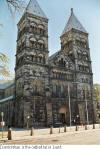

Lund was
founded by Sven Tveskägg at the end of the 10th century. At
that time Scania was a part of Denmark. Denmark was a kingdom with several
strong chieftains. Lund became a central place for the new religion,
Christianity. In 1060 Lund got their first bishop. The church owned 80% of
all the land in the town. 27 churches were built during the Middle Ages in
Lund. Only the Cathedral
 (Domkyrkan) and Sankt Petri are left today. The
diocese of Lund included Scandinavia and Greenland. The Cathedral was
built in the 12th century. (Domkyrkan) and Sankt Petri are left today. The
diocese of Lund included Scandinavia and Greenland. The Cathedral was
built in the 12th century.
In the
12th century, Lund was the biggest town in Scandinavia. There
were 3000-4000 inhabitants. Lund is with another town, Sigtuna, Sweden’s
oldest towns. Ancient finds show that the town during the 11th
and 12th centuries had contacts with large parts of northern
and eastern Europe.
i
 Knut the Holy
by
Viktor M, Mathias
Knut the Holy
by
Viktor M, Mathias
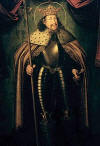
Knut the Holy
 was the king of Denmark 1080-1086. He was born in 1040 and
was the son of Sven Estridsson. He died on the 10th of July
1086 in Odense in Denmark. He was killed in Sankt Albans church and his
brother Oluf became the new king. After Knut died there was a famine in
Denmark for nine years and the people thought that it was a punishment
from God. There were rumours that miracles occurred at the dead kings
grave. The remains of his body were moved to a grave under the high altar
in the church. An unknown monk wrote a legend of a saint about Knut.
was the king of Denmark 1080-1086. He was born in 1040 and
was the son of Sven Estridsson. He died on the 10th of July
1086 in Odense in Denmark. He was killed in Sankt Albans church and his
brother Oluf became the new king. After Knut died there was a famine in
Denmark for nine years and the people thought that it was a punishment
from God. There were rumours that miracles occurred at the dead kings
grave. The remains of his body were moved to a grave under the high altar
in the church. An unknown monk wrote a legend of a saint about Knut.
Knut the
Holy’s letter of donation is the oldest known Nordic letter. The letter
from 1085 confirms a donation of land to the Cathedral in Lund, which was
being built during this time. Some of the land in 24 villages in Scania
and Zealand were donated to the church in Lund.
j
 Scania and Denmark
Scania and Denmark
 by Mats, Martin H, Viktor
by Mats, Martin H, Viktor
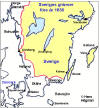
Scania belonged to Denmark already in the 9th century and Oluf
Fröhne was king in Scania around year 800. Another king was Ragvard Jarl
and he became king around year 860. The society changed a lot during the
Middle Ages because of the church and the royal power. Scania belonged to
Denmark during the Middle Ages. Scania was an important part of Denmark
and Malmö was one of the important Danish towns. The people in Scania
spoke with an eastdanish dialect. The coins were Danish. The king in
Denmark ruled over Scania. He built a stronghold in Malmö and a Cathedral
in Lund. The Danish archbishop was in Lund. Scania became Swedish
territory in 1658 after several years of war and confrontations between
the Danish and the Swedish people.
k
 The
life in an ancient village – an ordinary family, marriages, funerals,
important meetings and activities
by Lotta,
Ingrid, Maria, Tina The
life in an ancient village – an ordinary family, marriages, funerals,
important meetings and activities
by Lotta,
Ingrid, Maria, Tina





An
ordinary family
 :
As we
already know, Uppåkra was a very big village. There were probably many
families there. A newborn child became a member in the family when it got
a name. The Vikings waited 1-3 years to give the children a home, because
the baby mortality was high. The children helped much at home. They did
not go to school so they helped with farming, handicrafts, spinning wool
and cooking. The woman in the family was very independent. She made all
the work in the home with only the children’s help. It was a father’s duty
to teach the sons his skills, and a mother’s duty to teach the daughters
about the home. If the family did not work, it was acceptable to divorce. :
As we
already know, Uppåkra was a very big village. There were probably many
families there. A newborn child became a member in the family when it got
a name. The Vikings waited 1-3 years to give the children a home, because
the baby mortality was high. The children helped much at home. They did
not go to school so they helped with farming, handicrafts, spinning wool
and cooking. The woman in the family was very independent. She made all
the work in the home with only the children’s help. It was a father’s duty
to teach the sons his skills, and a mother’s duty to teach the daughters
about the home. If the family did not work, it was acceptable to divorce.
Marriages  :
New
families were born through marriages. People sometimes got married out of
love, but the richer they were, the more often it happened that the
marriages were arranged. The brides brought a dowry like money, property
or land. Many men often competed about marrying rich heirs and even rich
widows. The father of the bride received a ‘brides gift’ by the
bridegroom, but it was not as expensive as the dowry because the girls
were not as important as the boys. During hard times it happened that
newborn girls were put out to die, so that their parents did not have to
provide for them. The wives had to be faithful but the men could take
female slaves or servants as concubines. :
New
families were born through marriages. People sometimes got married out of
love, but the richer they were, the more often it happened that the
marriages were arranged. The brides brought a dowry like money, property
or land. Many men often competed about marrying rich heirs and even rich
widows. The father of the bride received a ‘brides gift’ by the
bridegroom, but it was not as expensive as the dowry because the girls
were not as important as the boys. During hard times it happened that
newborn girls were put out to die, so that their parents did not have to
provide for them. The wives had to be faithful but the men could take
female slaves or servants as concubines.
Funerals  :
There
are many different theories about how the people in the Iron Age got
buried. They could be buried in different burial mounds and sometimes the
rich and important people got buried in ships. They often had things with
them in their graves like food, clothes, pieces of jewellery, needlework,
weapons and kitchen equipment. They could even get buried with their
horses, dogs, peacocks, and even slaves if they had. Some people got
burned at bonfires. Under the funeral there was a woman called ‘The angel
of the dead’. She closed the eyes and mouth of the dead and dressed the
dead in their best clothes. They did believe very well in a life after
death. Unfortunately, there are not so many graves found in Uppåkra. :
There
are many different theories about how the people in the Iron Age got
buried. They could be buried in different burial mounds and sometimes the
rich and important people got buried in ships. They often had things with
them in their graves like food, clothes, pieces of jewellery, needlework,
weapons and kitchen equipment. They could even get buried with their
horses, dogs, peacocks, and even slaves if they had. Some people got
burned at bonfires. Under the funeral there was a woman called ‘The angel
of the dead’. She closed the eyes and mouth of the dead and dressed the
dead in their best clothes. They did believe very well in a life after
death. Unfortunately, there are not so many graves found in Uppåkra.
Important meetings
 :
There
was an important group in every village that made all the decisions. We
assume that there was one of these groups in Uppåkra. In that case maybe
they had their meetings in the temple. Every free man and woman had the
possibility to join and rule the council. All the councils from every
village used to meet and discuss twice a year, in autumn and in spring.
Then they determined laws and other things that was important at that
time. All the people in the village got together if a new leader should be
chosen. :
There
was an important group in every village that made all the decisions. We
assume that there was one of these groups in Uppåkra. In that case maybe
they had their meetings in the temple. Every free man and woman had the
possibility to join and rule the council. All the councils from every
village used to meet and discuss twice a year, in autumn and in spring.
Then they determined laws and other things that was important at that
time. All the people in the village got together if a new leader should be
chosen.
Activities  :
During
the winter the adults could enjoy themselves with sports like for example
wrestling, ball games and altercation. That could end with death. They
also climbed up mountains or jumped off high cliffs so they could prepare
themselves for battles. Even backgammon could end with blood. When there
was snow, people could go skiing or skating. The skates were made out of
bones that were tied to a leather shoe. :
During
the winter the adults could enjoy themselves with sports like for example
wrestling, ball games and altercation. That could end with death. They
also climbed up mountains or jumped off high cliffs so they could prepare
themselves for battles. Even backgammon could end with blood. When there
was snow, people could go skiing or skating. The skates were made out of
bones that were tied to a leather shoe.
l
 Handicraft
– iron, metals, wood and textiles
by Sabine, Annelie Handicraft
– iron, metals, wood and textiles
by Sabine, Annelie
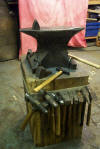

Iron  :
To produce iron was very important during the Iron Age. Because iron was
so important, it gave its name for the whole period. Iron was used to
manufacture tools and weapons. :
To produce iron was very important during the Iron Age. Because iron was
so important, it gave its name for the whole period. Iron was used to
manufacture tools and weapons.
Metals:
Next
after iron, bronze was very common to use for handicraft. Bronze is a mix
of copper and tin. Bronze was often used to make jewellery, different
kinds of mountings and different kinds of brooches. These were often
decorated. The brooches were foremost used for holding the clothes
together. Jewellery were also made of gold and silver.
Wood:
The
Vikings long ships are the most famous handicraft made of wood during the
Iron Age. In the Viking Age other fine objects were also made of wood.
Fantasy pictures, mostly of animals, could also be made in wood and then
seen on both everyday objects and on more exclusive grave gifts.
Textiles
 :
During
the Iron Age, linen and wool dominated the textiles. Exclusive cloth like
silk was imported, and sometimes leather and skins were used. People
dressed very practical. A kind of shirt of linen was worn closest to the
body. Other clothes like trousers, tunics and mantles were made of wool.
Weights of clay from looms are often found on Iron Age sites. Then it is
possible to see how important weaving was. :
During
the Iron Age, linen and wool dominated the textiles. Exclusive cloth like
silk was imported, and sometimes leather and skins were used. People
dressed very practical. A kind of shirt of linen was worn closest to the
body. Other clothes like trousers, tunics and mantles were made of wool.
Weights of clay from looms are often found on Iron Age sites. Then it is
possible to see how important weaving was.
m
 The
Middle Ages - clothes, shoes, jewellery, food and cooking The
Middle Ages - clothes, shoes, jewellery, food and cooking
by Tanja, Emelie,
Michanna
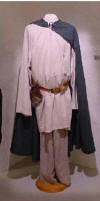
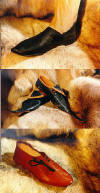
Clothes
 :
During the early part of the Middle Ages, the dress stayed within the
scope of the humans “natural” frame. The neckline went high up, and over –
and underwear could sometimes be pulled over the head. You made use of the
whole piece of the cloth and cut the garment in simple models to get width
and shape. The dress was often brightly coloured with clear colours put
together. They used wool and sometimes linen, fur and leather. The clothes
could have decorations like embroidered or applied ornament borders round
the neck, wrist and in the lower edge. The belts were slim tied in a knot
or provided with a clasp and the long ends hang free. To the married women
a headscarf was compulsory. In year 12-1300, a change in the climate led
to that the people had to wear thicker layers of clothes. An overskirt was
introduced to both women and men. Around year 1300, the earlier loose fit
women dress became narrower in the waist. No more concealing the figure,
but hold up the figure from the shoulder to the waist. People of higher
status were dressed in more expensive dresses. The people should know
“ones place” in society and dress after that. :
During the early part of the Middle Ages, the dress stayed within the
scope of the humans “natural” frame. The neckline went high up, and over –
and underwear could sometimes be pulled over the head. You made use of the
whole piece of the cloth and cut the garment in simple models to get width
and shape. The dress was often brightly coloured with clear colours put
together. They used wool and sometimes linen, fur and leather. The clothes
could have decorations like embroidered or applied ornament borders round
the neck, wrist and in the lower edge. The belts were slim tied in a knot
or provided with a clasp and the long ends hang free. To the married women
a headscarf was compulsory. In year 12-1300, a change in the climate led
to that the people had to wear thicker layers of clothes. An overskirt was
introduced to both women and men. Around year 1300, the earlier loose fit
women dress became narrower in the waist. No more concealing the figure,
but hold up the figure from the shoulder to the waist. People of higher
status were dressed in more expensive dresses. The people should know
“ones place” in society and dress after that.
Shoes
 :
People
used shoes in the Middle Ages and there were even different kinds of shoes
to choose between. The shoes were made of cow- sheep or goatskin and
sometimes decorated with some kind of fur. In the winter, the people
stuffed their shoes with straw. When the roads were dirty and sometimes
wet they took a piece of wood and tied it to their shoes with leather
straps. During the long winter, the roads got filthier and wetter, and
this resulted in thicker and thicker wood pieces under the shoes. During
the 11th-12th centuries, the people started to use
shoes in a style that was tied on the side. In the 13th –14th
centuries a new style became popular and the shoe was now tied on its
front part. This kind of shoe had more in common with our shoes today.
There was also a kind of shoe that had a very long front, almost like a
trunk. They were popular both during the 12th century and
during the 15th century. Some claims that the higher skill you
had in the society, the longer “trunk” you had on your shoes. In some
cases the “trunk” was so long that you had to tie them up to your knees,
but this probably only happened in the royal company. :
People
used shoes in the Middle Ages and there were even different kinds of shoes
to choose between. The shoes were made of cow- sheep or goatskin and
sometimes decorated with some kind of fur. In the winter, the people
stuffed their shoes with straw. When the roads were dirty and sometimes
wet they took a piece of wood and tied it to their shoes with leather
straps. During the long winter, the roads got filthier and wetter, and
this resulted in thicker and thicker wood pieces under the shoes. During
the 11th-12th centuries, the people started to use
shoes in a style that was tied on the side. In the 13th –14th
centuries a new style became popular and the shoe was now tied on its
front part. This kind of shoe had more in common with our shoes today.
There was also a kind of shoe that had a very long front, almost like a
trunk. They were popular both during the 12th century and
during the 15th century. Some claims that the higher skill you
had in the society, the longer “trunk” you had on your shoes. In some
cases the “trunk” was so long that you had to tie them up to your knees,
but this probably only happened in the royal company.
Jewellery:
People
have always used jewellery. In the Middle Ages you used both gold, silver
and bronze. Rings were usual. You wore them on each finger. Necklaces were
also very common, but first under the late Middle Ages. The rich people
could wear thick laces, often in gold. For the poor ones, there were
leather straps. You did not always use the necklaces as they are worn
today. Instead, they could sometimes be sewed on to your clothes, often
many necklaces after one another. But of course there were people who used
them as they are meant to be used. When the people became Christian, it
was common to wear necklaces with crosses. Both men and women used to
pierce their ears. A thing you can see on many pictures is the fibula.
Women had them on their dresses. The fibulas had different kind of
patterns.
Food and
cooking:
We know
pretty much about kitchen tools. If you should boil something, there were
kettles and pots to use. The Frying pan came sometime in the 1300’s. The
people ate and drank most often with objects that were made of wood. The
food varied a lot depending on if it was an ordinary weekday or a party.
There were also differences between the food that the rich people ate and
the food that the poor people ate. Bread and porridge were base food. A
common family could have porridge and bread for breakfast, and for dinner
they could have cabbage soup or maybe vegetable soup with bread and salted
herring. People drank water and sometimes beer. During the fast you were
not allowed to eat meat or party food, so you ate fish instead. All kinds
of fish were put on the table. Every Friday it was fast day. Before Easter
and Christmas the fast time was longer than usual. More than half of the
days of the year were fast days. The day after a long fast, they had a big
party day. Maybe 10-15 different dishes were served. A party dinner on the
Easter day could be union soup, rye bread, sausages or boiled pike. They
could have German beer or French wine to drink. Rye bread was everyday
food and the white bread was for parties. They ate pretty healthy back
then, but also unhealthy food like honey. On the summer they often ate
eggs and picked nuts, berries and fruits from the wood. The men often had
knives in their belt. They used it to hunt and to eat with. The most
common way to eat was with your fingers.
n
 Fiction
– two famous books: Fiction
– two famous books:
by
Malin,
Marta
Trägudarnas land – ‘The land of the pagan gods’. Author: Jan Fridegård
In a small Viking village, a slave woman lived who was pregnant. When the
child was born the Viking who got most power decided that the child was
going to die. Two men took the child and sat it out to die in the forest,
but the child’s father, who was a slave too wanted to have the child so he
ran after the two men to find the child. Then he and his wife hid in the
forest. One day a man from the village came and found them. The man fought
with the slaves and they killed him. They could not stay in the forest so
they stole a boat and sailed away. They came to a city and found a house
to live in. In the city they met a priest and he told the woman to believe
in his god because he was kind to slaves. The Vikings from the village
that the slaves had escaped from, came to the city to celebrate the gods
and the slaves were found.
Röde orm – ‘Red snake’.
Author:
Frans G. Bengtsson
Vikings captured Red snake and after a while he became friend with them.
They sailed all over the world. When he was in Denmark he fell in love
with the king’s daughter Ylva. He sailed down to the Middle East and they
had to pray to their god. He was given a nice necklace and a sword. When
he was going home he sailed to England. Before he sailed home, he sailed
to Denmark and took Ylva and a priest with him home. When he came home he
built a house and a church.
|